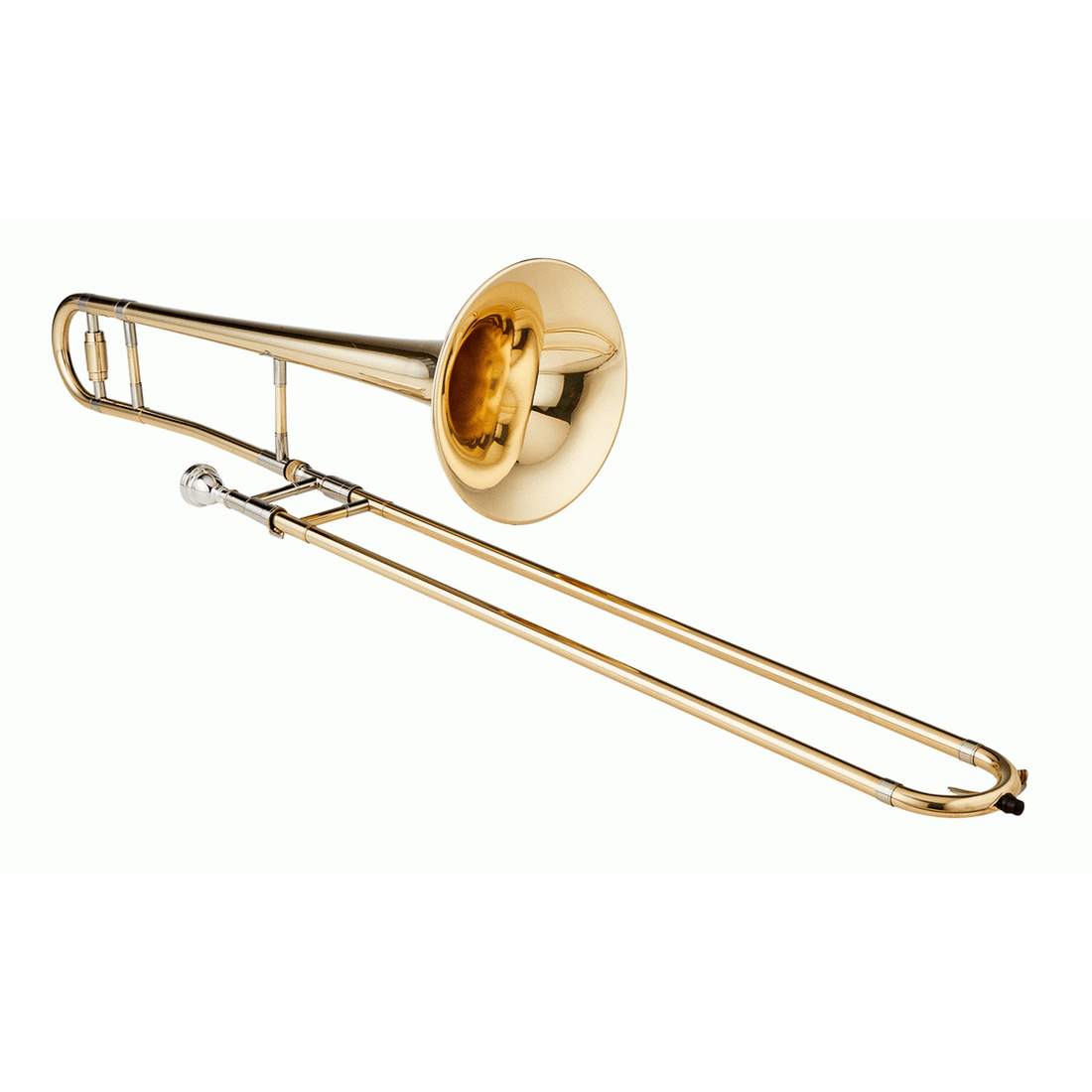The trombone, a distinguished member of the brass family, stands out for its unique slide mechanism, which allows for seamless glissando and precise pitch adjustments. Its rich, powerful, and versatile tone makes it an indispensable instrument in orchestras, jazz ensembles, brass bands, and various contemporary genres.
This guide, developed by Joondalup Music Centre in Perth, offers a comprehensive overview of trombones, addressing crucial considerations for musicians at all levels, from those embarking on their musical journey to seasoned professionals. We will delve into the intricacies of construction materials, explore popular brands and models, discuss the nuances of sound quality, outline essential maintenance protocols, and examine the cost implications associated with instruments across different proficiency levels.
Construction Materials and Their Sonic Influence
The materials used in a trombone's construction profoundly impact its tonal characteristics, response, and durability.
Brass Alloys (Bell and Slide Sections):
- Yellow Brass: The most common alloy (approximately 70% copper, 30% zinc), it offers a balanced tone that is bright and clear. Often used in student and intermediate models.
- Gold Brass (Rose Brass): Contains a higher percentage of copper (around 80% copper, 20% zinc), resulting in a warmer, mellower, and darker tone with richer overtones. Popular in intermediate and professional instruments.
- Red Brass: Possessing the highest copper content (around 90% copper, 10% zinc), it produces the warmest and darkest sound, often found in professional models.
Slide Material (Inner Slide):
- Nickel Silver: A durable alloy (copper, zinc, nickel) used for inner slide tubes. It provides a smooth, fast, and corrosion-resistant surface crucial for the slide's action.
Finish:
- Clear Lacquer: The most common finish, providing a protective coating and a bright sound.
- Silver Plating: Offers a slightly darker, more focused tone and a luxurious appearance, but requires more frequent polishing.
- Gold Plating: Primarily for aesthetic appeal, though some players believe it offers a subtle warmth to the sound.
Leadpipe Material: The leadpipe (the tube where the mouthpiece is inserted) can also vary in material (e.g., brass, nickel silver) and bore size, significantly influencing the instrument's response and tonal character.
The Range of Trombones: Types and Sizes
While the tenor trombone is the most common, other types exist, each with distinct roles and tonal qualities.
- Tenor Trombone: The standard trombone, typically pitched in B♭. It is available in various bore sizes (narrow, medium, large), influencing the instrument's response and projection. Some tenor trombones include an F attachment (a rotor valve that extends the range by a perfect fourth), increasing versatility.
- Bass Trombone: Larger than the tenor, often with a larger bore and bell, and typically features two rotor valves (F and G♭ or D). It produces a deep, resonant tone, serving as the bass voice in trombone sections.
- Alto Trombone: Pitched higher than the tenor (often in E♭ or F), the alto trombone is smaller and produces a brighter sound. It is less common but used in some classical orchestral and solo works.
Popular Trombone Brands and Models: A Journey Through Proficiency
The trombone market is diverse, with brands offering instruments tailored to different skill levels and musical demands.
Beginner Trombones:
- Brands like Yamaha (e.g., YSL-154), Jupiter (e.g., JTB-1100), and Beale (e.g., TB Series) are excellent choices for beginners. These instruments are typically made of yellow brass, feature durable construction, and are designed for ease of playability, making them forgiving for students developing their embouchure and slide technique. They are often lighter weight and come with basic, robust cases.
Intermediate Trombones:
- Intermediate players may opt for models from Yamaha (e.g., YSL-445G, YSL-545R), J Michael (e.g., TB400M), or King (e.g., 606). These trombones often introduce features like gold brass bells for a warmer tone, improved slide action, and sometimes an F attachment. They offer a step up in tonal quality and response, allowing for greater musical expression and suitability for school bands and local ensembles.
Professional Trombones:
- Professional trombonists gravitate towards instruments from renowned manufacturers such as Vincent Bach (e.g., 42B, 50B), Conn (e.g., 88H), King (e.g., 2B, 3B, 4B), Yamaha (e.g., Xeno series), Edwards, Shires, and Getzen (e.g., Eterna). These instruments are meticulously crafted from premium materials, feature precise engineering for superior intonation, projection, and response. They offer a wide range of customisation options (bell size, bore size, leadpipe, valve types) to suit individual playing styles and orchestral demands.
Sound Quality: Crafting the Trombone's Voice
The trombone's sound quality is a complex interplay of its physical attributes and the player's technique.
- Bore Size: The internal diameter of the tubing influences the instrument's resistance and sound. Narrow bore trombones (e.g., .500") are brighter and more suitable for jazz, while large bore trombones (e.g., .547" or larger) produce a fuller, darker, and more orchestral sound.
- Bell Size and Material: Larger bells generally offer greater projection, while the bell material (yellow brass, gold brass, red brass) significantly shapes the instrument's timbre.
- Leadpipe Design: The leadpipe's taper and material affect the instrument's response and intonation across registers.
- Valve Type (F-attachment and Bass Trombones): Rotor valves are standard, but alternative valve types like Thayer valves or Axial flow valves can offer a more open feel and less resistance when the F-attachment is engaged.
- Player's Embouchure and Air Support: Ultimately, the player's control over their breath and lip vibration is paramount in shaping the trombone's unique voice.
Maintenance Protocols: Preserving Your Instrument
Proper maintenance is crucial for ensuring the longevity, optimal performance, and smooth operation of a trombone.
- Slide Care: The most critical aspect. The outer slide should be wiped clean regularly, and a high-quality slide lubricant (cream or oil) applied to the inner slide tubes. Water should be flushed through the slide frequently.
- Main Body Cleaning: The entire instrument should be bathed periodically (every few months) using lukewarm water and a mild soap solution, followed by thorough rinsing and drying.
- Water Key Care: The water keys (spit valves) should be checked for proper sealing. The corks may need replacement over time.
- Rotor Valve Care (if applicable): Rotor valves require periodic lubrication with rotor oil to ensure smooth and quiet operation.
- Preventing Dents: The trombone slide is delicate. Always store the instrument in its case when not in use and handle it with extreme care to prevent costly dents.
- Professional Servicing: Regular servicing by a qualified brass technician is essential for more comprehensive maintenance, such as addressing sticky valves, aligning the slide, cleaning internal tubing, and repairing any minor damage.
Cost Considerations: Investing in Musical Expression
The cost of a trombone varies significantly based on its quality, materials, and features.
- Beginner Trombones: Typically range from $300 to $800. These offer affordable options for students, often made of yellow brass with basic features, and usually include a mouthpiece and case.
- Intermediate Trombones: These instruments, featuring improved materials (e.g., gold brass bell), better build quality, and often an F-attachment, range from $800 to $2,500. They provide a noticeable step up in tone and playability.
- Professional Trombones: Crafted from premium materials with meticulous attention to detail and offering extensive customisation options, professional trombones start from $2,500 and can exceed $10,000 or more, especially for custom-built or specialist models.
- Accessories: Factor in the cost of essential accessories such as a high-quality mouthpiece, slide lubricant, cleaning kit, mute, and a robust case.
- Maintenance: Budget for regular maintenance, including cleaning supplies and periodic servicing by a technician.
Key Features:
- Unique slide mechanism allows for seamless pitch changes and glissandi.
- Construction materials like brass alloys and nickel silver impact tone and durability.
- Available in various types: Tenor (standard), Bass (deep voice), and Alto (brighter).
- Brands cater to all skill levels, from student-friendly to professional-grade instruments.
- Sound quality is shaped by bore size, bell material, leadpipe, and player technique.
- Regular maintenance, particularly slide care, is crucial for optimal performance and longevity.
FAQ:
Q: What is the F-attachment on a tenor trombone?
A: The F-attachment is a rotor valve system that extends the trombone's range downwards, allowing for lower notes and providing alternative slide positions for certain passages.
Q: How often should I lubricate my trombone slide?
A: The outer slide should be lubricated frequently, ideally before every playing session, to ensure smooth and fast action.
Q: Is it harder to play a trombone than other brass instruments?
A: Each brass instrument presents unique challenges, but the trombone's slide mechanism requires a different kind of precision and ear training compared to valve instruments.
Q: Can a beginner start directly on a professional trombone?
A: While possible, it's generally not recommended. Beginner trombones are more forgiving and less expensive, allowing students to develop fundamental skills before investing in a professional instrument.
Q: How do I choose the right bore size for a trombone?
A: Narrow bore trombones are typically for jazz or lead playing due to their brighter sound, while large bore trombones offer a fuller, darker tone preferred for orchestral or symphonic band playing.

